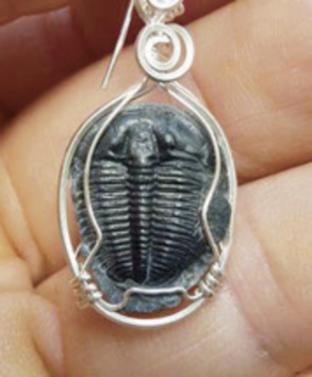Published in the Ocean Watch column, Honolulu Star-Advertiser © Susan Scott
January 2, 2012

Tiny trilobite fossils make unusual earrings.
For Christmas my husband gave me five dead animals and two shark teeth topped with several tumors from tortured oysters. That man knows the way to my heart. The gifts are three pairs of earrings and a necklace, all made from marine fossils. Local artisans honored these long-gone creatures by encasing them in pearl-studded swirls of silver and gold.
Two of my new earrings are trilobites, marine animals that crawled, drifted and swam eons ago.
The Paleozoic era ranged from about 500 million to 250 million years ago and marks the most important time in the planet’s history of animal life. (The later dinosaurs may disagree.) For reasons unclear, the animal kingdom exploded in diversity at the beginning of the era. At its end, though, 90 percent of those animals went extinct. Among those lost were all the trilobites.
Researchers believe about 20,000 species of trilobites existed. Most ranged from 1 to 4 inches long but some were so tiny they were invisible to the naked eye. The largest trilobites, nearly 3 feet long, must have looked like creatures from the black lagoon.
People weren’t freaked out by the critters because there were no people. Homo sapiens didn’t appear until about 200,000 years ago.
Trilobites were arthropods, an enormously successful and diverse animal group. Arthropods today have adapted to every nook and cranny of nearly every habitat on the planet. We know arthropods today as insects, crustaceans and other animals that wear their jointed skeletons on the outside. The division of this armor into plates and cylinders allows the animals to move. Molting allows them to grow.
My trilobite earrings are about the size of my thumbnail, but I have a pretend trilobite fossil that’s 7 inches long. I bought this rock in Morocco several years ago when the merchant waved me to a stop.
“Trilobites!” he said. “Cheap!”
On a table the man had a dozen flat sandstone rocks into which he had carved trilobite shapes. An instant giveaway was that he had painted his carvings all the same color. “Fossils,” he said with a hopeful smile.
Craig and I decided that the guy deserved an A for effort and some dirhams for artistry. And that’s how we came to have a big, brown, bogus trilobite hanging on our living room wall.
Real trilobites left such good fossil records of themselves that people have been able to glean countless details of the creatures’ lives, and therefore, the era.
No trilobites made it to the Holocene epoch (ours), but their name did. The horseshoe crab, a possible trilobite relative little changed for 400 million years, lays eggs that hatch into free-swimming young called trilobite larva because they look strikingly like trilobites.
©2012 Susan Scott